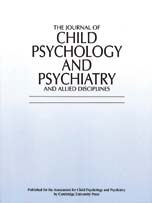Crossref Citations
This article has been cited by the following publications. This list is generated based on data provided by
Crossref.
Leekam, Susan R.
López, Beatriz
and
Moore, Chris
2000.
Attention and joint attention in preschool children with autism..
Developmental Psychology,
Vol. 36,
Issue. 2,
p.
261.
Connellan, Jennifer
Baron-Cohen, Simon
Wheelwright, Sally
Batki, Anna
and
Ahluwalia, Jag
2000.
Sex differences in human neonatal social perception.
Infant Behavior and Development,
Vol. 23,
Issue. 1,
p.
113.
Charman, Tony
Baron-Cohen, Simon
Swettenham, John
Baird, Gillian
Cox, Antony
and
Drew, Auriol
2000.
Testing joint attention, imitation, and play as infancy precursors to language and theory of mind.
Cognitive Development,
Vol. 15,
Issue. 4,
p.
481.
van der Geest, Josef Nicolaas
Kemner, Chantal
Camfferman, Gert
Verbaten, Marinus Nicolaas
and
van Engeland, Herman
2001.
Eye movements, visual attention, and autism: a saccadic reaction time study using the gap and overlap paradigm.
Biological Psychiatry,
Vol. 50,
Issue. 8,
p.
614.
Baird, G
Charman, T
Cox, A
Baron-Cohen, S
Swettenham, J
Wheelwright, S
and
Drew, A
2001.
Screening and surveillance for autism and pervasive developmental disorders.
Archives of Disease in Childhood,
Vol. 84,
Issue. 6,
p.
468.
Charman, Tony
and
Baird, Gillian
2002.
Practitioner Review: Diagnosis of autism spectrum disorder in 2‐ and 3‐year‐old children.
Journal of Child Psychology and Psychiatry,
Vol. 43,
Issue. 3,
p.
289.
Lutchmaya, Svetlana
Baron-Cohen, Simon
and
Raggatt, Peter
2002.
Foetal testosterone and eye contact in 12-month-old human infants.
Infant Behavior and Development,
Vol. 25,
Issue. 3,
p.
327.
Baron-Cohen, Simon
2002.
Is Asperger Syndrome Necessarily Viewed as a Disability?.
Focus on Autism and Other Developmental Disabilities,
Vol. 17,
Issue. 3,
p.
186.
2002.
Blackwell Handbook of Childhood Cognitive Development.
p.
620.
Elgar, Kate
Campbell, Ruth
and
Skuse, David
2002.
Are you looking at me? Accuracy in processing line–of–sight in Turner syndrome.
Proceedings of the Royal Society of London. Series B: Biological Sciences,
Vol. 269,
Issue. 1508,
p.
2415.
Lutchmaya, Svetlana
and
Baron-Cohen, Simon
2002.
Human sex differences in social and non-social looking preferences, at 12 months of age.
Infant Behavior and Development,
Vol. 25,
Issue. 3,
p.
319.
Baron-Cohen, Simon
2002.
The extreme male brain theory of autism.
Trends in Cognitive Sciences,
Vol. 6,
Issue. 6,
p.
248.
Frith, U.
Hill, E. L.
Swettenham, John
Condie, Samantha
Campbell, Ruth
Milne, Elizabeth
and
Coleman, Mike
2003.
Does the perception of moving eyes trigger reflexive visual orienting in autism?.
Philosophical Transactions of the Royal Society of London. Series B: Biological Sciences,
Vol. 358,
Issue. 1430,
p.
325.
Frith, U.
Hill, E. L.
and
Charman, Tony
2003.
Why is joint attention a pivotal skill in autism?.
Philosophical Transactions of the Royal Society of London. Series B: Biological Sciences,
Vol. 358,
Issue. 1430,
p.
315.
Klin, Ami
Chawarska, Katarzyna
Paul, Rhea
Rubin, Emily
Morgan, Thomas
Wiesner, Lisa
and
Volkmar, Fred
2004.
Autism in a 15-Month-Old Child.
American Journal of Psychiatry,
Vol. 161,
Issue. 11,
p.
1981.
Klein, Stanley B.
German, Tim P.
Cosmides, Leda
and
Gabriel, Rami
2004.
A Theory of Autobiographical Memory: Necessary Components and Disorders Resulting from their Loss.
Social Cognition,
Vol. 22,
Issue. 5,
p.
460.
Dawson, Geraldine
Toth, Karen
Abbott, Robert
Osterling, Julie
Munson, Jeff
Estes, Annette
and
Liaw, Jane
2004.
Early Social Attention Impairments in Autism: Social Orienting, Joint Attention, and Attention to Distress..
Developmental Psychology,
Vol. 40,
Issue. 2,
p.
271.
JEPSEN, JENS RICHARDT MØLLEGAARD
2004.
Gennemgribende udviklings- forstyrrelser i barne- og ungdomsalderen; en litteraturgennemgang.
Nordisk Psykologi,
Vol. 56,
Issue. 1,
p.
50.
Mesibov, Gary B.
Shea, Victoria
Schopler, Eric
Adams, Lynn
Merkler, Elif
Burgess, Sloane
Mosconi, Matt
Chapman, S. Michael
Tanner, Christine
and
Van Bourgondien, Mary E.
2004.
The Teacch Approach to Autism Spectrum Disorders.
p.
91.
Plauche Johnson, Chris
2004.
Autistic Spectrum Disorders in Children.
p.
83.

